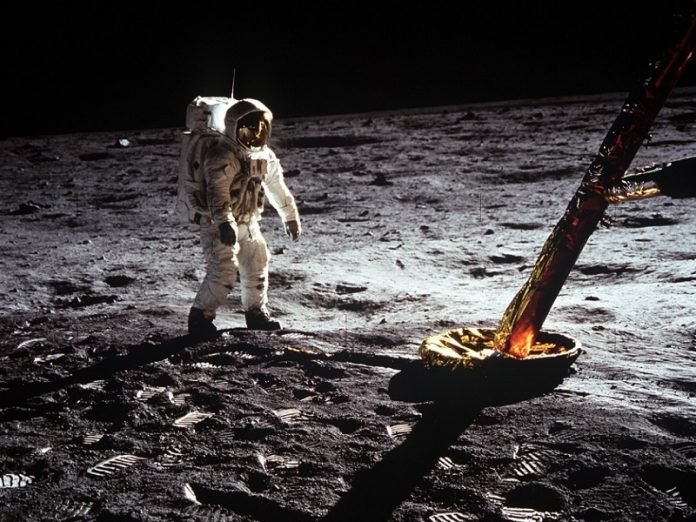
It’s hard to overstate the significance of the Apollo 11 moon landing on July 20, 1969.
Whether you view it as an unlikely feat of engineering, a definitive surge ahead in the Cold War, or even just really, really good live TV, Neil Armstrong’s “giant leap for mankind” emerges as one of the defining moments of human history.
To celebrate the 50th anniversary of this unprecedented technological and cultural milestone, experts in various disciplines—including a professor who worked on the thermal analysis for the lunar module—weigh in on how the space program continues to shape their fields today.
‘Nobody knew how to do that’
Gunter Georgi, industry professor and course director for “Introduction to Engineering and Design” at the Tandon School of Engineering at New York University, describes his experience working on the thermal analysis for the lunar module and outlines the technological advances the mission inspired:
Advances in aerospace engineering
“Aerospace engineering, like all engineering disciplines, has changed dramatically in the 50 years since the moon landing,” says Richard Thorsen, chair in the mechanical and aerospace engineering department at the Tandon School of Engineering at New York University.
“Some drivers of that change have been the rapid advance of supercomputing—both in terms of speed and capacity—and the miniaturization of devices, which is very important in modern aerospace engineering, where weight is so important, particularly in spacecraft.
“The evolution of materials, too, during the past 50 years has changed aircraft and spacecraft design. The options are so much greater today than they were in the Apollo era,” Thorsen says.
“Today we would do it so much more easily and in some sense better because of the tools that we have. And these new tools permeate all of the aerospace industry, not just space exploration.”
Journalism and ‘the infinite voyage’
“The first three Earthlings to reach the moon profoundly influenced American journalism by turning many of the reporters and editors who covered the epic feat of a lifetime—and who, by tradition, were supposed to ‘stay out of the story’—into unabashed, blatant, cheerleaders and aspiring space travelers themselves,” says William E. Burrows, a professor emeritus of journalism and SHERP founder and director emeritus.
“Reporters and other correspondents who ordinarily produced stories that described the human race’s sordid side, including wars, purges, and other atrocities—and even those who covered the exploits of brave adventurers who climbed Everest, flew over the poles, and crossed oceans in frail craft—were so awed by the Apollo 11 astronauts being the first to reach another world and actually land on it that they became virtual celebrants themselves,” Burrows says.
“The moon landings changed journalism by literally raising the sights—the aspirations—of those who covered it.
As their predecessors wanted to take to the air after Lindberg’s and Byrd’s glorious adventures, many who covered Apollo 11 and the flights that followed it became addicted to the infinite voyage and wanted to share that ultimate adventure. That, in the jargon of the trade, would make them part of the story.”
Astronaut food
“The postwar mid-20th century United States is often called the ‘golden age’ of food processing.
While the mass production and processing of food began earlier, it was World War II that spurred technology, innovation, and product development.
Military researchers, in alliance with food manufacturers, freeze-dried, pounded, packaged, dehydrated, and preserved food in order to feed the US military, as well as allies and newly-independent former Axis nations,” says Amy Bentley, professor of nutrition and food studies at the Steinhardt School of Culture, Education, and Human Development.
“After the war, food manufacturers turned their attention to American consumers eager to spend their dollars.
In this era television came of age and advertised the food products, which were readily stocked in grocery stores. Consumers were fascinated by the conveniences and novelty of the new products: ready to eat canned spaghetti, instant coffee, TV dinners,” Bentley says.
“The 1960s and 1970s were the heyday of the Apollo space program. The Cold War space race was in full swing, and JFK and presidents afterward felt the need to compete with the USSR on land and in space.
“As with WWII, the space program spurred on technologies focused on food preservation and product development to ensure that the men sent into space would be adequately nourished, both physically and psychologically,” she says.
“The entire country was enamored with NASA and the Apollo space program. Astronauts were genuine heroes, and fashions, furniture, and home décor—even popular culture (think of The Jetsons!)—reflected the public’s fascination with space.
“Among the two most notable were Tang instant beverage, a powder that, when stirred into water, replaced orange juice, and Pillsbury Space Food Sticks, long Tootsie Roll-type candies that were either chocolate or peanut butter flavored and contained some nutrients,” Bentley says.
“Kids thought they were totally cool, and in an age where mass-produced, shelf stable foods were ubiquitous, the products were wildly popular. As a kid during that period, my sisters and I begged my mom to buy both.
Neither product was remarkable as far as taste was concerned, as I remember, but taste wasn’t really primary. The products felt modern, it was cool that the astronauts ate them too (or products like them), and we enjoyed their novelty.
“I would say the legacy of space-inspired food products is significant. Americans still drink large quantities of beverages from powders (such as Country Time Lemonade and others), and Tang is still around.
And while space food has come a long way, our food supply is still dependent on technologies developed and perfected in the mid- to late-20th century. Breakfast bars, energy ‘goo’ packets, and freeze-dried camping food are remnants. And instant coffee is still popular, too,” she says.
Beyond the limits of early software engineering
“The software used on the lunar lander is seen as a tour de force that would be almost inconceivable today.
It had minuscule memory and incredibly slow hardware, from today’s point-of-view, and yet it supported concurrent processes with different priorities,” says Ed Schonberg, professor emeritus of computer science at the Courant Institute of Mathematical Sciences.
“Since then, the methodology for the construction of reliable software systems has become much more rigorous, and makes use of formal verification tools, formal testing procedures, and high-level programming languages.
The FAA requires such procedures to be used when constructing software systems for aerospace, and similar requirements apply to transportation systems and medical devices,” he says.
Space travel and medicine
“Technologies developed for space travel have benefitted health and medicine in various capacities,” says Maya N. Clark-Cutaia, assistant professor at the Meyers College of Nursing.
“One lesser-known innovation is a chemical process developed under a NASA contract that removes toxic waste from used dialysis fluid, or dialysate. Essentially, under this ‘sorbent’ system, a much smaller volume of dialysate is cleaned and replenished for use rather than being drained and requiring additional fluid from a continuous water source to maintain additional dialysis sessions,” she says.
“Additionally, cost reduction has made them particularly attractive for home maintenance hemodialysis.
Sorbent technology is now being incorporated into both home and dialysis centers by one major for-profit company and for use with the first wearable kidney. I expect that this trend will only gain momentum.”
Written by Eileen Reynolds.



